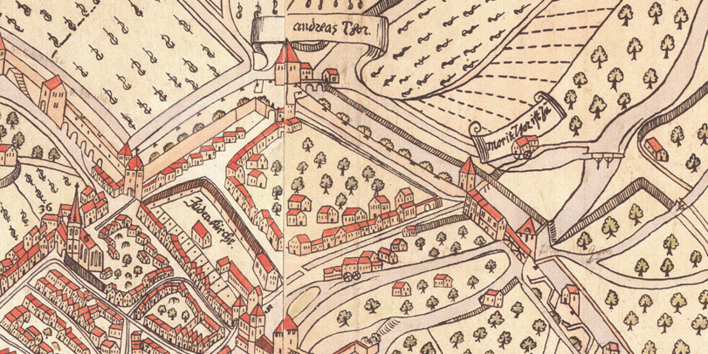
Erfurt, Germany. Early view showing area of former Jewish cemetery. Source: http://juedisches-leben.erfurt.de/jl/de/
Germany: More Medieval Gravestones Discovered in Erfurt
One February 9, 2013, the Thüringische Landeszeitung (click for photo) reported that more medieval gravestones have been discovered in the German town of Erfurt, where the city has already preserved its medieval synagogue and mikveh. Twenty fragments of medieval matzevot, dating from the thirteenth through the fifteenth century, were discovered at a construction site between Andreas Road, Great Ackerhofgasse (formerly the site of the Moritz Gate) and Moritzstraße, near the cemetery site.
This brings to 58 the number of stones, originality from the medieval cemetery, that have now been rediscovered. Three of gravestones are presently on view in the Old Synagogue. The new pieces, apparently carved from a high-quality sandstone so that their inscriptions are still legible, have been taken for study to the Angermuseum. Art historian Mary Stürzebecher, the Unesco Bauftragte for the city has been examining the stones with archaeologist Karin Sczech by the State Office of Historic Monuments and Archaeology.
The oldest stone can be dated to 1259 when it was erected in meomry of for “(wife) Dolze, daughter of Mr Asher”.
The Jewish population was expelled from Erfurt in 1453 and the cemetery was subsequently abandoned. Stones were removed and used for building material. Eventually a communal barn and grain depot were built on the site.
Erfurt is presently hoping to have its medieval Jewish heritage listed as a UNESCO World Heritage, and the discovery of the gravestones may help this claim. The UNESCO application is a common one in collaboration with the cities of Mainz, Worms and Speyer, where the Jewish history is more widely known having been celebrated continuously for centuries - except during the Nazi period. Only one UNESCO site per country can be named in any given year.

Erfurt, Germany. Old Synagogue. Photo: Michael Sander2009 (Wikimedia Commons)
Included in the UNESCO nomination are the Old Jewish Synagogue, known in the 1920s (Krautheimer wrote about it) but only re-identified in 1992. It dates from the eleventh century, and was damaged and then subsequently reused after pogroms of 1349.
The synagogue stood in the center of the historical old quarter very close to the Merchants Bridge and the town hall. Original building parts include the four thick outer walls, the Romanesque narrow arched windows, the Gothic rose window and the entrance to the main prayer room. Converted into a museum in 2009, it includes a ground floor exhibition the tells the story of the building and its many uses over the centuries.

Most impressive, however, is the magnificent Erfurt Treasure is on display in the synagogue-museum basement. The treasure, found by accident in 1998, is believed to have been hidden in a nearby medieval cellar during the 1349 pogrom and never retrieved. The largest part of the 28-kilogram hoard consists of 3141 silver coins and 14 silver ingots of various sizes. More important though are the 700 individual pieces of Gothic jewelry, including a golden Jewish wedding ring from the early fourteenth century which was featured on a German stamp soon after its discovery. The collection, which was exhibited at the Yeshiva University Museum in New York in 2008-2009, also includes brooches, belt buckles, trimming for robes and dresses plus silver dishes and cups.
Click here for more on the Jewish sites in Erfurt
Click here for information on visiting the Jewish sites in Erfurt, and more about other attraction in the town.
It's amazing to see and study these old gravestones! It just shows how important they have been for so many hundreds of years in remembering loves who have been lost. I wonder what people in the future will say when studying our monuments to loved ones. http://www.syracusemonumentscny.com
ReplyDelete